All published articles of this journal are available on ScienceDirect.
Effect of Strength and Durability of Sand Cement Brick Containing Recycled Concrete Aggregate and Cold Bottom Ash
Abstract
Introduction
The market price of brick has risen sharply due to the insufficient brick supply. Therefore, implementing RCA as one of the alternative materials for sand replacement is significant. The consumption of natural aggregate (NA) can be reduced by using the RCA. It is a good step to utilize recycled concrete to minimize the problem of excess waste materials. The results of using RCA and CBA as sand replacements contribute to better performance in compressive strength as compared to the normal brick. The density of the brick was also reduced by 4.95% as the RCA and CBA took place in the brick. Besides that, the water absorption was decreased when incorporating RCA and CBA in the cement brick due to less free water in the mix and fewer voids.
Aims
This study aims to ascertain the performance, strength, and durability characteristics of sand cement bricks incorporated with RCA and CBA as partial replacements for sand.
Methods
Percentages of 1.5%, 3.0%, 4.5%, and 6.0% of CBA and 15%, 30%, 45%, and 60% of RCA were chosen for partial sand replacement. The brick had dimensions of 215 mm in length, 65 mm in depth and 105 mm in width. Density, compressive force, and water absorption tests were undertaken after each of the three varied ratios of water to cement (1:5, 1:6, and 1:7).
Results
The finding indicates that with the optimum RCA and CBA replacement and the correct water to cement ratio, the performance of the new brick is better than the normal brick.
Conclusion
The optimum sand-to-cement ratio is 1:6, according to the overall results of selecting the optimal sand-to-cement ratio by density, compressive strength, and water absorption test. However, the result for the density value shows that the average brick density is inferior to the control brick. For all of the sample bricks, the compressive strength was best at a sand cement ratio of 1:6. However, as each of the samples complies with the British Standard criterion of less or equal to 15% absorption, it was determined that the sand cement brick's capacity for water absorption was sufficient.
1. INTRODUCTION
Brick was commonly used as a construction material in civil engineering. Almost all infrastructure needs sand, cement, and brick. This concept was successfully used in Malaysian construction, where sand cement bricks were used in almost all residential and commercial structures. A sand cement brick is a block used in masonry buildings that includes fine aggregate and cement. It demonstrates that 50% and 75% of RCA's substitution of natural sand substantially impacts the brick's functionality [1]. As the market for sand cement brick grows, so does the use of natural resources. It will reflect that natural resources for making sand cement bricks are limited due to high energy consumption. Aside from that, due to insufficient brick supply, the market price of brick has risen sharply. This is because manufacturers, especially in cities in Malaysia, were limited in their ability to obtain natural resources for brick production. The retail price of brick would increase, affecting low-cost residential houses.
As we acknowledged, brick is the main construction material worldwide and concrete structure is mostly used in civil engineering. To create a clean and natural environment, using waste materials to produce bricks can be implemented to conserve natural resources. Therefore, implementing RCA as one of the alternative materials for sand replacement is significant. The consumption of natural aggregate (NA) can be reduced by using the RCA. Therefore, it is a good step to utilize recycled concrete to minimize the problem of excess waste materials. RCA has rough textured, elongated and angular particles compared to NA, which has a smooth texture and rounded compact aggregate [1].
While this is happening, CBA is created in coal furnaces from agglomerated particles that are too big to travel in the flue gases and through the grate to an ash hopper at the bottom of the furnace [2, 3]. Physically granular, rough, porous, and grey in hue, bottom ash particles have these characteristics [3]. The properties and characteristics of CBA are related to river sand properties, which make CBA significant to be used as a replacement material [4, 5]. It has been discovered that using RCA and CBA in the construction sectors, particularly in the cement sand brick sector, is a positive move toward sustainable materials. The study aimed to contribute to and assist in improving pollution-free building technologies in Malaysia. As a result, although new materials are projected to benefit the nation and the environment, it is not anticipated to provide additional revenue for the cement sand brick sector. Therefore, RCA and CBA are the most suitable materials that can be used as partial sand replacement materials in the construction industry. The construction cost will be reduced by using industrial wastes and helps to protect the natural environment from the disposal of wastes. There are currently no data or studies on the effectiveness of using RCA and CBA as a partial sand replacement material for brick. Consequently, this study aims to ascertain the performance, strength, and durability of sand cement bricks comprising a combination of RCA and CBA as partial sand replacement materials.
2. METHODOLOGY
Portland cement (PC), by MS 522:2007, was the type of cement utilized. This used 1.5%, 3.0%, 4.5%, and 6.0% of CBA and 15%, 30%, 45%, and 60% of RCA were chosen for partial sand replacement. The brick had dimensions of 215 mm in length, 65 mm in depth and 105 mm in width. A machine that could handle pieces up to 5 mm carried out the crushing operation. RCA is shown in Fig. (1) after sieving. The specific gravity of the fine aggregates was 2.86. Granules of sieved waste CBA with a maximum size of 5 mm are seen in Fig. (2).
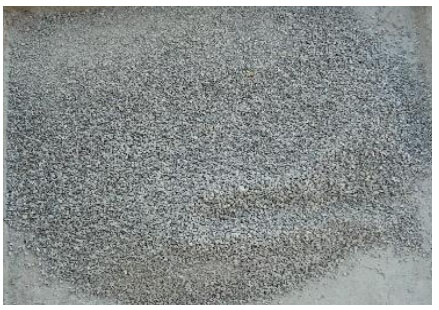

Density, compressive force, and water absorption tests were undertaken after each of the three varied ratios (1:5, 1:6, and 1:7). The procedure of air curing (7 and 28 days) was chosen since it entails keeping samples at an appropriate temperature. The combinations were created in compliance with the British Standard requirement, and the design mix for cement sand brick utilized BS EN 9982 [6-9].
3. RESULTS AND DISCUSSION
3.1. Density
Figs. (3 to 5) shows the density of the sample at 7 and 28 days with brick ratios of 1:5, 1:6 and 1:7, respectively.
It demonstrates that RCA and CBA containing sand cement blocks weigh less than control specimens. The bulk of the brick samples was reduced due to the addition of RCA and CBA. The lowest density for 28 days was 2047.89 kg/m3 at a percentage RCA60CBA4.5, 4.95% lower than the control brick. The total outcome also reveals that the average density of bricks containing RCA and CBA is significantly lower compared to the control sample bricks.

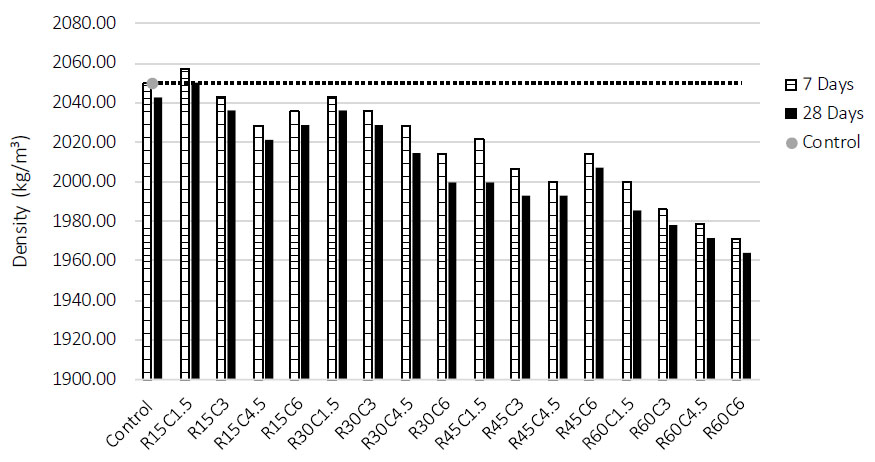

This pattern resembles that described by Khalid et al. [10], who found that when the RCA level in brick combinations increased, the density decreased noticeably. It suggests that the RCA's insertion, which lowers the specific gravity of the natural aggregate, caused the density to drop. According to Bustamante et al. [11], the amount of CBA in the mixes causes the densities of the created composite bricks to decrease. In other words, the brick density decreases due to the reduced unit weight of RCA and CBA.
3.2. Compressive Strength
According to BS 6073, the compressive strength test was performed [12] for 7 and 28 days. This study examines how various mix design ratios and cure times affect the utilization of RCA and CBA as fine aggregate replacement materials. Figs. (6 to 8) list the compressive strength experimental findings.
According to Fig. (6), all sample's strengths were significantly increased than the required minimum. According to BS 6073 [13], bricks' compressive strength shall not be less than 7 N/mm2. The RCA30CBA1.5 brick had a strength of 23.84 MPa, greater than the control brick's value. Adding more than 1.5%, CBA decreased the compressive strength of RCA15CBA4.5 and RCA15CBA6. However, R30 indicates that the significant strength increases with the rise in RCA and CBA percentages for RCA30CBA1.5, with 30% of RCA having a greater impact on the value of the sample's compressive strength. But when the proportion of CBA fillers in the brick composition increases for RCA30CBA4.5 and RCA30CBA6, the sand cement bricks' compression strength declines. The consistent bonding and improved compaction between RCA and CBA depended on the fineness of the CBA particles.
According to Fig. (7), the high-performance compressive strength for RCA45CBA3 at 28 days was 35.52 MPa. Despite this, the combination of RCA and CBA compressive strength values was deemed adequate because all samples above the BS 6073-1 [13], or more than 7 MPa, standard value. Additionally, it can be shown that the compressive strength increased by adding 3.0% of CBA for all RCA percentages for both ages. However, the compressive strength decreased as RCA and CBA percentages increased.
RCA15CBA3, RCA30CBA4, RCA45CBA3, and RCA60CBA1.5 had the highest compressive strengths compared to the control samples. Compressive strength rose for all brick samples when 3.0% of CBA was added, while for combination RCA60, the strength increased at 1.5% of CBA. As a result, adding 4.5% and 6.0% of CBA to the samples reduced the loss of strength.
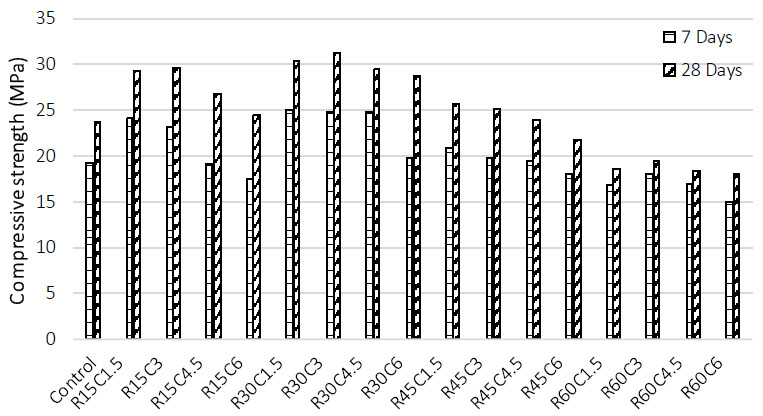
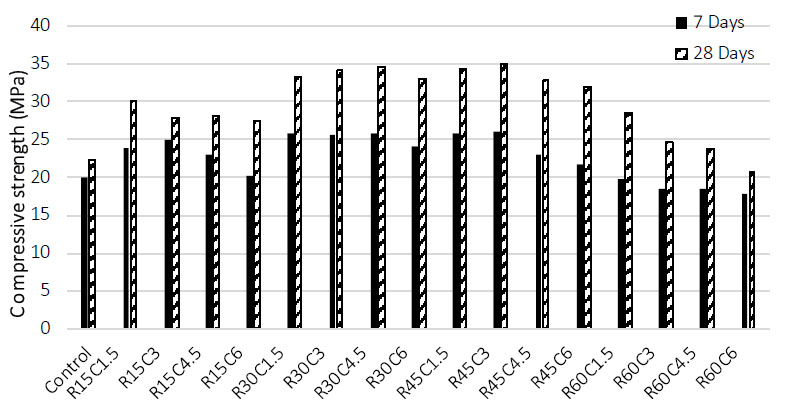
The maximum compressive strength was attained by RCA30CBA1.5, as shown in Fig. (8). Compressive strength increased from the control brick by 41.52% to 28.82 MPa. Starting with RCA30CBA3, the compressive strength began to decline until RCA30CBA6. The increase in RCA and CBA in the samples, which causes an increase in porosity in the sample bricks, is what causes this decrease. However, the poor bonding between cement pastes containing RCA and CBA could be a factor in the decline in compressive strength. It relied on CBA particle fineness, promoting consistent bonding and improved compaction between RCA and CBA. This indicates that as CBA concentration rises, so does the compressive strength of brick samples containing CBA. This study's findings are consistent with those of Yaacob [1], who discovered that adding 50% RCA to brick samples enhanced their compressive strength, supported by Ghazali N. et al., shows the same increment of compressive strength at 50%. However, the compressive strength decreases if more than 50% of RCA is present. Conclusions from research by Dina and Mohamed [14] and Bustamante et al. [11] and showing agreement that high RCA and CBA content adversely impact brick compressive strength can be used to support the conclusions of this investigation. The results also show that just a particular quantity of CBA is a significant strength when adding 15%, 30%, 45%, or 60% of RCA. The findings of this investigation are consistent with those of studies by Irwan et al. [15] and Ali et al. [16], which found a strong connection between aggregate and binder as a rise in the percentage of synthetic plastic may lead to a reduction in the strength of materials.
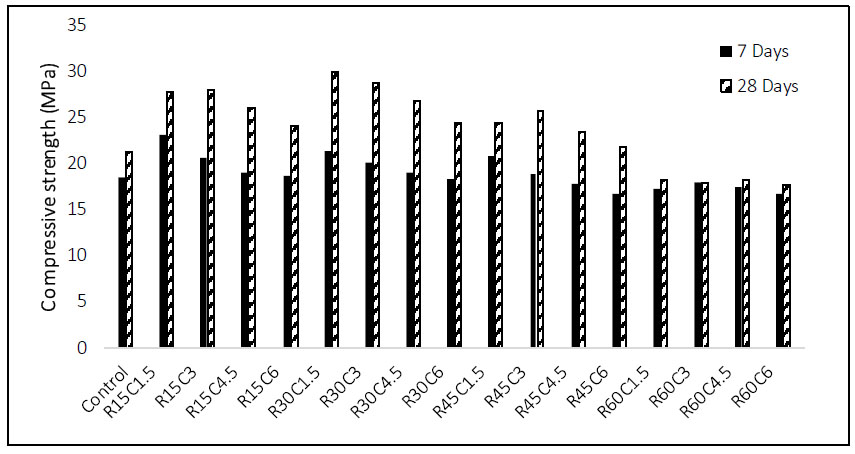
The study's findings demonstrate that adding RCA and CBA in various mix design ratios may effectively positively contribute to the value of compressive strength. On the other hand, it can be deduced that when the RCA and CBA replacement is greater than 45%, the strength of the bricks starts to decline and increases as the percentage level of the RCA and CBA content grows up to 50%.
3.3. Water Absorption
Samples were evaluated for their ability to absorb water since it has been determined that suction is a crucial component of bond strength in bricks. Figs. (9 to 12) show the relation of brick containing RCA and CBA with water absorption performance.
The data from various CBA percentages with 15% of RCA and a brick with a 1.5 ratio are shown in Fig. (9). The percentages of water absorbed for RCA15CBA1.5, RCA15CBA3, RCA15CBA4.5, and RCA15CBA6 were 4.38%, 4.47%, 4.39%, and 4.48%, respectively. Because there was less free water in the mix and fewer voids, brick with a 1.5 ratio containing RCA15 experienced a reduction in water absorption. As a result, particle cohesiveness increases while the capillary suction absorption rate decreases. Similar patterns in water absorption were seen in brick samples with a ratio of 1:6 and CBA in all percentages. Meanwhile, the sand-cement brick at a 1.7 ratio was reported to have the maximum percentage of water absorption. The result indicates water absorption of 4.67%, 4.77%, 4.58% and 4.69% for RCA15CBA1.5, RCA15 CBA3, RCA15CBA4.5 and RCA15CBA6, respectively.
Fig. (10) indicates that the water absorption percentages increase when the CBA percentage and cement sand ratio increase. Compared to cement-sand ratios of 1:6 and 1:7, the lowest water absorption value was shown when the cement-to-sand ratio of 1:5 for all tested CBA percentages. When compared to RCA30, RCA30CBA4.5 has the lowest water absorption rating with a cement-to-sand ratio of 1:5. Less water migrated outward into the cured cement paste's capillary pores due to the porosity of the brick is low, which reduced the amount of water absorption. However, the amount of mortar that adheres to the RCA particles also affects how much water bricks absorb [17, 18]. In conclusion, these samples absorbed less water than previous RCA30 samples with a cement-to-sand ratio of 1:5. However, for cement-sand ratios of 1:6 and 1:7, water absorption declined as RCA and CBA concentration increased, except for RCA30CBA6, which demonstrated an increase in water absorption.


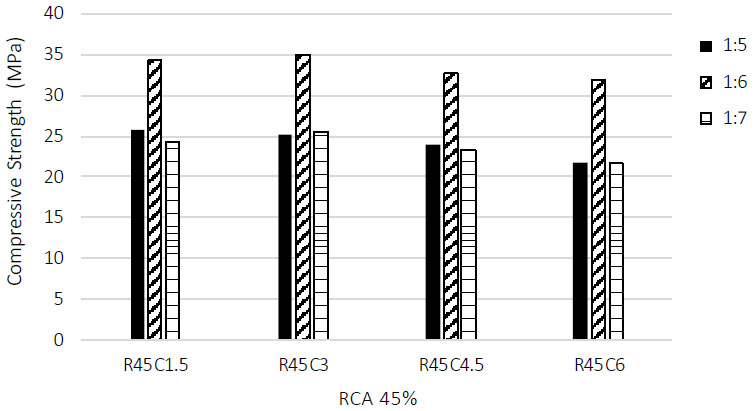

The water absorption findings of brick samples with 45% RCA and various CBA percentages and cement-sand ratios are shown in Fig. (11). Water absorption increases along with higher cement-sand ratios and CBA percentages. The cement-sand ratio of 1:5 produced the lowest result. The water absorption percentages of RCA45CBA1.5, RCA45CBA3, RCA45CBA4.5, and RCA45 CBA6 were 5.11%, 5.03%, 5.14%, and 4.88%.
Sample of RCA60CBA1.5, RCA60CBA3, RCA60CBA4.5, and RCA60CBA6 all attained comparable water absorption percentages, as illustrated in Fig. (12). For all of the varied CBA percentages, the lowest water absorption value was shown by the 1:5 cement to sand ratio compared to 1:6 and 1:7 cement to sand ratios respectively, but highest water absorption value exhibits by RCA60CBA6 when compared to RCA60 with a 1:5 and 1:6 cement to sand ratio.
The water absorbability of R60 samples with all cement-sand ratios was improved. For RCA60 sand cement bricks, the attachment of old mortar residue to recovered aggregates increases water absorption and porosity. Due to the closely bound aggregates, which reduce the pore rate and increase brick density, bricks containing 15%, 30%, and 45% of RCA showed poorer permeability [19, 20]. Despite this, it was determined that the water absorption percentage of sand cement bricks was appropriate because all samples met the standards of BS 3921 which called for not more than 15% of water absorption [21].
In contrast, it can be said that brick containing RCA and CBA significantly acceptable performance in water absorption behaviour. The data shows that bricks with a ratio of 1:5, CBA contents at all percentages and RCA 15% were found to be less permeable than other bricks. Therefore, it is anticipated that when the content of RCA and CBA rises, the density will decrease while water absorption will increase [22].
CONCLUSION
The optimum sand-to-cement ratio is 1:6, according to the overall results of selecting the optimal sand-cement ratio by density, compressive strength, and water absorption test. However, the result for the density value shows that the average brick density is inferior to the control brick. For all of the sample bricks, the compressive strength was best at a sand-cement ratio of 1:6. However, as each one of the samples reached the British Standard criterion of less or not exceeding 15% absorption, it was determined that the sand cement brick's capacity for water absorption was sufficient.
This study was important to determine whether environmentally green building bricks were effectively developed since the design qualities met the requirements. This study also benefits the building sector by lowering construction costs and making it possible to collect waste materials. In addition, this research was useful to the government since it showed how garbage may be recycled into a substance that might be used to address environmental issues.
HIGHLIGHTS
• RCA and CBA containing sand cement block weigh less than control specimens.
• The addition of more than 1.5% CBA decreased the compressive strength.
• Ideal water-to-cement ratio can increase the performance of brick.
LIST OF ABBREVIATION
| NA | = Natural Aggregate |
| PC | = Portland cement |
AVAILABILITY OF DATA AND MATERIAL
The data used to support the findings of this study are included within the article.


